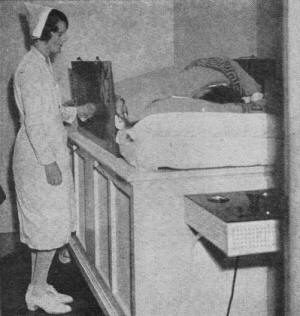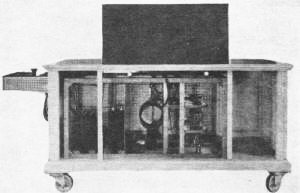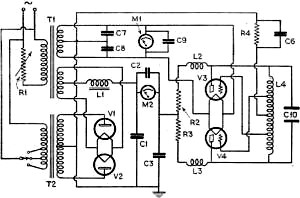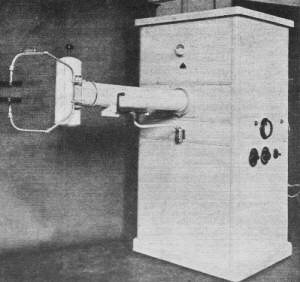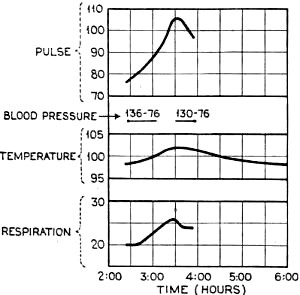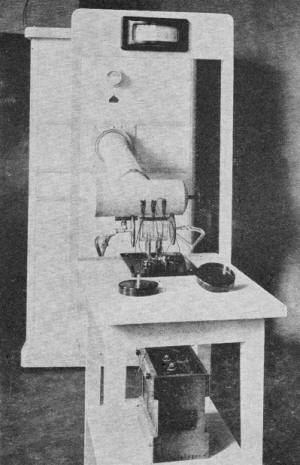Radio Fever - Using HF Electric Fields in Modern Medicine |
|||||||
"My God, man! Drilling holes in his head isn't the answer! Now put away your butcher knives and let me save this patient before it's too late!" Those classic words were uttered by Dr. McCoy in "Star Trek IV: The Voyage Home," after Lt. Chekov (promoted from Ensign after the TV series) sustained brain damage as a result of falling from a "nuclear wessel" when 20th century naval surgeons were about to open his skull to relieve pressure from swelling. Look at these images from a 1932 article on using radio waves "to produce protective fever in killing germs of a number of diseases." 10 to 30 meters was a popular wavelength band at a power of about 500 watts. The patient's body part to be treated is placed between the plates to act "as a dielectric" while the liquids are heated via induced oscillations similar to how a microwave oven works. How did the doctors know when the treatment was complete? A thermometer in the mouth was monitored for a temperature rise of about 1 degree Fahrenheit. Yikes. Anyone out there think that the opinions of a consensus of 'experts' should never be challenged?
Radio Fever How High-Frequency Electric Fields are used in Modern Medicine to Produce Radio Fever By Irving J. Saxl, Ph.D.
Radio sciences, heretofore used primarily for communication in various forms, have opened a new field beneficial to humanity. The author tells of recent investigation in using short radio waves in connection with their therapeutic effects in raising the body temperature to produce protective fever in killing germs of a number of diseases Now it is possible, with the use of radio waves produced by machines similar to radio transmitters of the short-wave type, to heat up the human body and to give it the therapeutic benefit of raised temperature (fever) in a purely physical way, without the use of chemicals. A new and valuable tool is thus presented by the physicist to the physician; a clean process which can be easily controlled without the aid of the drug store and the apothecary. What is fever? Fever is an increase of the normal body temperature, together with a general functional derangement, a higher pulse rate, etc. A body with raised temperature has marked changes in its metabolism; for instance, it is able to eliminate poisons, destroy bacteria and other destructive elements of the body at an increased rate. This is of tremendous importance for maintaining health. For instance, in a body infected with bacteria, the heat-regulating mechanism automatically raises the temperature in such a way that the disease virus finds less favorable living conditions at the new temperature. But the diseased body cannot always help itself in a sufficient degree. It has been found necessary in many instances to raise the temperature of the body by chemical means, e.g., the injection of proteins, malaria and other germs, which in producing the curative fever often produced other unfavorable reactions. Fever in a Limited Area
If there was only a small part of the body which should have been raised to a higher temperature, it was necessary to heat the entire body, although, naturally, a limited area can stand a much more severe temperature increase than a general treatment. Now radio has made it possible to heat up the desired limited areas to temperatures far above those obtainable by chemical means, and under fully controllable conditions. What is this wonder instrument which can perform these effects, and how does it work? This so-called fever machine, in its essential parts, consists of a transmitter similar to a radio transmitter for short waves. A high-frequency field is generated by this transmitter, but the energy is not radiated into space by an aerial system, but concentrated between two or more condenser plates. In this high-frequency field, without any galvanic contact, the body of the patient is placed, the body acting as a dielectric between these plates. Every electric current, direct current as well as alternating, heats up the body it passes into. For the body to stand a satisfactory amount of current with an analogous temperature increase, without undue changes in its physiological and chemical composition, a high-frequency current has to be used. Only if frequencies of the order of millions of cycles per second are used do the excitation of muscular contractions, known as faradization, and of chemical reactions due to polarization, known as galvanization, cease. Figure 1 shows a general picture of a so-called fever machine, or radio-thermic oscillator. The short-wave transmitter is located in the lower part of the case. The high-frequency oscillations are obtained from a simple short-wave transmitter which is fed by a push-pull circuit, delivering about 500 watts. Two tubes of the vacuum type are employed, each delivering about 250 watts. About 380 to 400 milliamperes in plate current is consumed. In the radio-thermic oscillator shown above two tubes, type 504-A or its equivalent type UV-204-A, are used. The transmitter works on 110 to 115 volts, alternating current, of 50 to 60 cycles, and requires about 15 amperes input from the current supply. The plate voltage is produced by a transformer shown at the left side of the picture in Figure 1. The high-tension current is rectified by two full-wave mercury-vapor rectifiers, and the voltage variations are smoothed out by filters. The inductance of the high-frequency circuit consists of about nine windings, with coils of about 10 inches diameter. The capacity in the transmitter circuit are the two plates located at the top of the cabinet, and the patient is placed between them as a dielectric. The Circuit Essentials
This apparatus is about 6 feet long. 36 inches wide and 30 inches high. The condenser plates slide down into slots without removal. The instruments for controlling the current intensity and the wavelength at the right side of the picture) are placed in such a way that they are easily accessible. This machine delivers about 10 megacycles, corresponding to a wavelength of about 30 meters. Figure 2 gives a diagram of this machine. The diagram, together with the data mentioned before, is self-explanatory. V1 and V2 are rectifier tubes in a full-wave circuit, from which the plate voltage is taken for the operation of the vacuum tubes V3 and V4. These operate upon the self-inductance coil L4 in push-pull and create the high-frequency field applied around the plates of the condenser C10, between which the patient is placed. Apparatus of a similar type is also used by A. Gosset, G. Lakhowsky and others in France, and by Esau in Jena. The General Electric Company also has entered this field. Gosset and his collaborators had an adaptable apparatus which was able to work on wavelengths as short as 2 meters. The frequency is measured by a small oscillating wavemeter circuit, consisting of an inductance, a condenser and a little flashlight bulb in series with it. For determining the wavelength, the condenser is turned slowly until the filament starts lighting. Then the wavemeter is removed as far s possible, thee condenser being regulated so that the filament of the lamp just glows. The exact wavelength of the main radiation is at that point where the filament just glows up for a single condenser reading. Care has to be taken not to burn out the lamp by moving the condenser too quickly while the wavemeter is near the transmitter, as the increase in power "grows" swiftly as the condenser approaches the point of resonance. For working with high sensitivity, the wavemeter has to be removed from near the oscillator, so that the filament just shows a faint glow. The machine developed by Amy, Aceves and King, Inc., in cooperation with Dr. Ramirez, of the French Hospital, New York City, uses an air mattress, upon which the patient is laid between the condenser plates; rubber and air being an excellent insulator, so that the high-frequency field is not lessened and can work within the body of the patient. Method of Treatment
For heating up the patient, the entire apparatus, which is on rollers, is removed from any location near walls which contain steel, as this naturally would tend to induce high-frequency currents within the structural material. The patient is rolled in blankets and placed between the condenser plates. It has proven practical to dress the patient, first, in a woolen union suit. Thus perspiration is removed automatically and cannot accumulate, in drops, upon the skin. This is important, as these fluid drops heat up quicker than the body and cause burns upon the skin ." The position of the patient is important. If we place one hand be-tween the condenser plates, and the current is put on, the hand will feel the heat quicker if the hand is held in an imaginary plane which connects the condenser plates. The temperature increase, however, is less under equal current conditions when the hand is held parallel to the plates. This experiment can be performed easiest with one of the small condenser machines described later in this article. For heating up the patient more quickly, his feet and shoulders are arranged so that they touch opposite plates. The apparatus is arranged so that about one degree temperature increase takes place in 15 minutes, the temperature being measured by a thermometer in the mouth of the patient. The patient is heated and kept in his warm blankets after the current has been turned off. It is interesting to note, in this connection, that the pulse rate increases for some time after the patient has been removed from the high-frequency field. The fever does not stop immediately after the patient is taken out of the condenser. Thus he keeps his "fever" temperature for several hours. Warm lemonade and tea are given him to replace the loss of fluid substance and to increase perspiration. If the fever does not stop by itself after a prescribed time, ice bags are administered. This method produces less strain on the heart of the patient and is certainly more effectively controlled by the physician than with quinine and other chemicals after malaria or protein injections. Charts showing the temperature increase have been prepared by Dr. Ramirez, as shown in Figure 4. These also give data for the changes of the pulse rate and the respiration during the fever treatment. Blood Pressure and Other Reactions There are decided changes which take place in the blood picture of the treated patient and in his other reactions. Experiments on animals have been made showing that the temperature returns to normal quite rapidly as long as the animal has not been heated over 42 degrees Celsius.* Animals heated above that temperature for a longer period of time have been killed. A decided loss of weight takes place, ranging from about two to ten percent of the body weight, according to the length and intensity of the treatment. Also it makes a great difference whether the sweating and feverish body is allowed to replenish its loss of water. There are also marked changes in the different steps of metabolism and in the non-protein nitrogen of the blood. According to Knudson and Schaible, this increased in several instances up to 200 percent. Red blood cells and total white cells are increased too, and, in addition, the microscopic analysis of the blood shows a number of immature forms of red blood cells. Figures 3 and 5 show another improved form of machine for localized fever treatment. This is the machine of Esau and Schliephake, of Jena. The high-frequency oscillator is entirely built-in within a metal cabinet connected to the ground, thus protecting the oscillating circuit from any capacity influence of body parts near it. By using these small electrodes instead of the large ones, it is possible to produce fever in a limited area of the body and to avoid the dangerous and exhausting effects of a general fever even with physical apparatus.
The G. E. Co. has lately produced a fever machine which was demonstrated at the last convention of the New York Electrical Society, at the Engineering Auditorium. The plates of this machine are about twice as large as those of Schliephake, giving a somewhat less localized action. With this machine Dr. C. F. Tenney, Jr., attending physician of the Fifth Avenue Hospital, treated 580 cases of rheumatism since last April, with results which were so encouraging that several patients who had come on crutches were able to discard them after a number of treatments. Whether this fever machine will give a permanent cure in severe cases of arthritis is still too early to determine. But certainly the cures already effected are almost as miraculous as the "wonder cures of the saints." The wonders of the twentieth century are thus seen coming from the laboratories! Short-Wave Experiments At the short-wave experiments performed in Vienna, the physicians and other people having to do with the machines during their operation wear metal-coated laboratory coats and caps. Metal-weave ribbons were sewed upon the outside of these garments, as electromagnetic frequencies of this range do not penetrate such shieldings. Figure 5 shows an interesting experiment made by Dr. Esau. Between the plates of the high-frequency generator a number of cells are placed which resemble, in a rough way, parts of animal tissues. These cells are filled with a fluid of similar electric characteristics as the cell content of body tissues. The temperature is controlled automatically in different parts of the fluid by thermo-elements inserted in the cells. Thus data can be read directly on the meter on top of the instrument, with reference to the heating effect of different frequencies under various conditions. For the mathematical determination of the heating of a body of primarily dielectric properties it has been found that it depends primarily from the composition of the electrolyte, from its concentration, from its size and form and from the wavelength." According to the classical field theory of James Clerk Maxwell, the characteristic wavelength of a body is determined by
Hereby λ the wavelength, ε the dielectric constant and x the conductivity of the substance. Taking the reciprocal value of equation (1), we derive the following expression:
In introducing in this equation (2) specific data, Paetzold† gave the following formula as an expression for the wavelength under which a body might expect its strongest heating effect:
where f = the frequency (reciprocal to the wavelength) g = the conductivity of the substance (the same as x) l = the length of the body q = the cross-section of the body a = reciprocal expression of the various equivalent capacitances involved in the arrangement k = the dielectric constant of the body (the same as ε) This means that the characteristic frequency for a substance has to be high if the dielectric properties of the substance are small. The frequency will be lower if the substance has a minor electrical conductivity.
There are many other biological applications possible and it may be expected that the radio sciences will open up a much wider field in influencing biological tissues than thought of today. For instance, an experiment has been made in Italy, where caterpillars of the silkworm were exposed to ultra-high-frequency fields. All of these silkworms hatched sooner and gave more silk than the untreated ones. However, this treatment is still too expensive today for practical use. One of the interesting experiments which have been made with this ultra-short-wave generator was to place flies in a glass body contained in ice. Ordinarily these flies died after a very short period of time. If, however, subjected to the influence of the radio-thermic oscillations, the flies continued to live in between the ice blocks. At a later date rooms might be heated with a radio-thermical process, using no caloric heat production but having the temperature raised in the body as induced by its dielectric properties in the field of high-frequency oscillations. At both ends of a room wires or metal plates might be built in in the walls, filling the space between them with high-frequency energy and thus heating up the persons in the room between the plates. The application of radio transmitting apparatus for the science of medicine promises to be a valuable tool in fighting disease. The application of radio waves, beginning with ultra-short waves with quasi-optical characteristics, up to normal short waves of about 30 meters wavelength, has opened unusual possibilities for the physician and new hopes for the sick.
* Arthur Knudson and Philip Schaible, Archives of Pathology, Volume II, pp. 728 to 743, 1931. ** J. Kowarschik: Electrical Short Waves and Their Importance in Medicine, Wiener Klinische Wochenschrift, Volume 30, pp. 957-962, July, 1931. † J. Paetzold: The Temperature Increase of Electrolytes in a High-frequency Condenser Field and Its Importance for Medicine. Zeitschrift fuer Hochfrequenztechnik, Volume 36, September, 1930, p. 85.
Posted September 11, 2020 |
|||||||


